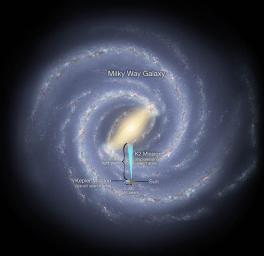
|
Map of Exoplanet Search Areas
- Click the image above for a larger view
- Full-Res JPEG (2400 x 2329) (264.1 kB)
- Full-Res TIFF (2400 x 2329) (10.4 MB)
Caption:
In a global experiment in exoplanet observation, the K2 mission and Earth-based observatories on six continents will survey millions of stars toward the center of our Milky Way galaxy. Using a technique called gravitational microlensing, scientists will hunt for exoplanets that orbit far from their host star, such as Jupiter is to our sun, as well as free-floating exoplanets that wander between the stars. The method can find exoplanets that are up to 10 times more distant than those found by the original Kepler mission, which used the transit technique.
The artistic concept illustrates the relative locations of the search areas for NASA's K2 and Kepler missions.
Background Info:
NASA Ames manages Kepler's ground system development, mission operations and science data analysis. NASA's Jet Propulsion Laboratory in Pasadena, Calif., managed Kepler mission development. Ball Aerospace & Technologies Corp. in Boulder, Colo., developed the Kepler flight system and supports mission operations with JPL at the Laboratory for Atmospheric and Space Physics at the University of Colorado in Boulder. The Space Telescope Science Institute in Baltimore archives, hosts and distributes the Kepler science data. Kepler is NASA's 10th Discovery Mission and is funded by NASA's Science Mission Directorate at the agency's headquarters in Washington.
More information about the Kepler mission is at http://www.nasa.gov/kepler .
More information about exoplanets and NASA's planet-finding program is at http://planetquest.jpl.nasa.gov .
Cataloging Keywords:
| Name | Value | Additional Values |
|---|---|---|
| Target | ||
| System | ||
| Target Type | Exoplanet | |
| Mission | Kepler | |
| Instrument Host | Kepler | |
| Host Type | Space Telescope | |
| Instrument | ||
| Detector | ||
| Extra Keywords | Artwork, Atmosphere, Color, Infrared, Map, Orbit | |
| Acquisition Date | ||
| Release Date | 2016-04-07 | |
| Date in Caption | ||
| Image Credit | NASA/Ames/JPL-Caltech | |
| Source | photojournal.jpl.nasa.gov/catalog/PIA20070 | |
| Identifier | PIA20070 | |
